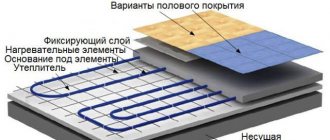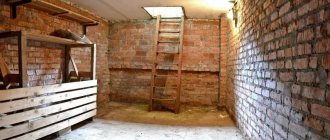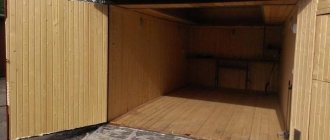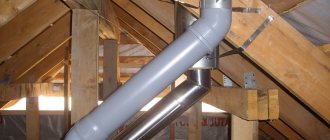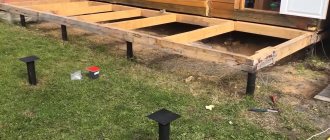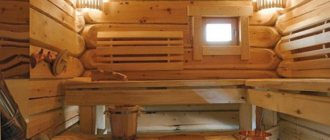The air exchange system in the garage is an important part of comfortable conditions for both the car and the car owner. Its arrangement does not require special construction skills or special engineering knowledge, but it is important to understand how to make ventilation in the garage so that air circulation is effective. We will understand the rules by which ventilation is arranged and how to make its operation stable and reliable.
Using flexible pipes for garage ventilation Source selfio.de
Ventilation schemes
There are three ways to establish air circulation in a garage, and there is no fundamental difference whether the garage box is equipped with a basement or not. The diagrams look like this:
- Natural ventilation. It works due to the fact that the temperature inside and outside the garage is different. Despite the simplicity of implementation, it requires some (simple) calculations.
- Forced (mechanical). It is divided into three types: supply, when outside air is forced in, exhaust, when air is removed from the room, and supply and exhaust. In the latter case, equipment (fans) is used for both air inflow and air outflow. The most effective, but also the most expensive scheme.
- Mixed (combined). Combines the two previous schemes: natural ventilation is supplemented by an exhaust duct fan. The combination provides a good result in spacious rooms.
Ventilation grille for air intake Source gazeta-pravo.ru
Stove chimney as an element of the ventilation system
Since in winter many motorists heat their garages with wood and oil stoves, a number of points should be taken into account when organizing air exchange:
- A boiler or furnace requires air to burn fuel. The heater takes it directly from the room, so you need to take care of replenishment - ensure an influx from outside.
- A properly installed stove chimney is a good exhaust hood that works constantly, even when the flame in the firebox goes out.
- From the previous paragraph it follows: the chimney pipe easily replaces the ventilation duct, so there is no point in assembling a separate hood. One condition: after extinguishing the stove and leaving the box, fully open the damper - the draft regulator in order to improve air exchange.
The stove chimney, with the draft regulator open, is capable of removing a sufficient amount of air
Food for thought. Often, owners of garages and private houses are prejudiced against ventilation. Argument: together with the removed air mass, the building loses heat. We answer: the amount of losses directly depends on the inflow - how much air the grille lets in, how much air the hood releases to the street.
Conclusion: adjust the cross-section of the inlet openings with doors and gates. The ideal option is to install a supply wall valve.
Adjustable inlet valve built into the external wall
Problems solved by the ventilation system
The need for ventilation is specified in SNiP, which specifies air exchange standards and related parameters. Air circulation established according to the rules allows you to solve the following problems:
- Removes high humidity from the air. If moisture has nowhere to go, it will begin to settle on the car. Constantly forming condensate will inevitably lead to metal corrosion.
- Condensation is harmful not only to the car, but also to the building structure, tools and things stored in the garage box (for example, a bicycle). Reducing humidity extends their service life.
- The ventilation system removes not only excess moisture, but also gasoline vapors, as well as chemical compounds derived from a running engine. The less you inhale this bouquet, the safer it is for your health.
- Air exchange maintains a comfortable temperature, which creates suitable conditions for long-term storage of food.
Ventilation diagram for a garage with a cellar Source nikastroy.ru
SNiP on dimensions and ventilation
SNiP rules provide for ventilation in garages without a basement (as in non-residential premises) with the following features:
- Constant air circulation is organized, and its parameters do not depend on the material from which the garage is built, whether it is brick, concrete or metal.
- The standards provide for an air exchange of 180 cubic meters per hour per passenger car. Conditions can be ensured using natural, forced or mixed ventilation systems.
- Additional (increased multiple) air exchange standards apply for rooms in which vehicle maintenance is carried out (repair, assembly, painting). In this case, the volume of the box is multiplied by the coefficient (multiplicity) of air exchange (standards are indicated for different types of work). For example, the coefficient for service stations is 6-8.
- The rules provide for the possibility of heating or not heating the garage space. Winter temperature +5°C is considered the most rational for storing a car. The owner would be more comfortable at +10-15°C, but in such conditions, ice and snow on the car create a humid environment.
Painting or welding work requires increased ventilation Source project-home.ru
To determine the amount of air that needs to be replaced in the garage per hour, perform the following calculations:
- The volume of the garage is calculated by multiplying its length, width and height. For example, for a building with dimensions of 6x4x2.5 m, the volume will be 60 cubic meters.
- If the owner is engaged in repairs and minor restoration, a coefficient for a service station of 6-8 is used.
- Multiplying the unit volume and the multiplicity gives 360-480 cubic meters per hour. This is the volume of air that should change every hour. Such circulation can be organized using only a mechanical ventilation system with the installation of round duct fans.
Recommendations
The criteria for installing ventilation system elements are the same for all garage compartments. Let us briefly list the main ones:
- the exhaust pipe is installed under the ceiling in the diagonally opposite corner from the inflow;
- the inlet inlet is located 15-20 cm above the floor and must be covered with a fine-mesh metal grille to protect against rodents;
- the diameter of the ventilation pipes is calculated in advance, based on the volume of the room, conditions, location, etc.;
- exhaust pipe - equal or less in diameter, but not larger than the supply pipe;
- to enhance traction, you can use mechanical means, diffusers, turbo deflectors, etc.;
- the exhaust outlet is located at a distance of at least 3 m from the supply inlet (for effective draft);
- the supply inlet is located above the ground at a level of 50 cm;
- In winter, it is necessary to insulate the hood so that frost and ice do not accumulate inside;
- in winter, you should ensure that the ventilation pipes always remain free of snow and frost;
- separate location of ventilation systems for garage buildings and basements.
Features of different types of ventilation
The natural scheme involves the movement of air through some kind of air duct (for example, ventilation is often built in a garage from sewer pipes). Due to the temperature difference, warmer (and lighter) air flow moves from bottom to top, giving way to cooler air mass.
Natural circulation has many advantages to become widespread enough. It is reliable and inexpensive, operates silently, is designed for long-term operation and does not require energy sources.
Calculation of ventilation system sizes Source nataros.ru
See also: Catalog of companies that specialize in engineering systems (heating, water supply, sewerage and others) and related work
From time to time, a shortcoming of the system appears: efficiency decreases noticeably in the summer, when the temperature difference becomes minimal. Performance is determined by the following characteristics:
- Temperature difference. The system works best when it is much warmer in the garage than outside. In this case, warm air is actively displaced by cold, denser outside air.
- Atmospheric pressure. From the physics course we know that with increasing altitude above sea level, pressure drops. To arrange air circulation in the garage, a very small pressure difference is enough. This can be organized by placing the inlet and outlet openings with a height difference of 3.5-4 m.
- By the wind. The wind creates a zone of high (windward) and low (leeward) pressure. This can be used to advantage if you install the inlet along the wind rose (from the side of the prevailing wind).
The mechanical system creates forced air exchange using electromechanical devices. It includes one or more fans, sensors, dampers with manual or automatic control.
A duct fan will ensure effective ventilation of the garage Source serebklych-uk.ru
The system is assembled according to one of three schemes: supply, exhaust or supply and exhaust, and has the following advantages:
- Its effectiveness is not affected by weather conditions and time of year.
- Allows you to adjust (if there is a controller) air exchange parameters. You can change the performance and temperature to achieve a comfortable environment.
- It is possible to organize a warm influx, that is, in fact, alternative heating.
- The forced scheme is convenient to use in a garage located in the basement (below ground level).
The disadvantage of the automatic circuit is its complete volatility. It also requires funds for the purchase and installation of equipment. During operation, it needs increased attention, and periodically, qualified maintenance.
Combined ventilation is implemented as natural ventilation, supplemented by a fan. If you use a garage box only for car storage, you can use a household fan for the hood; Ventilation of the garage basement requires additional equipment.
The right microclimate will help preserve the harvest Source nataros.ru
The main advantage of the combined scheme is its efficiency: it mainly operates in natural mode, the fan is connected when the natural outflow cannot cope. Disadvantage: the need to install additional elements.
Sewer pipes: main characteristics
Modern manufacturers offer three main options for sewer pipes:
- Made from polyvinyl chloride (PVC).
- Made from polypropylene.
- Made of polyethylene (corrugated).
Each of them has its own specifics and characteristics, but they all have a certain list of advantages:
- Affordability. Sewer pipes most often have the most affordable price for the general public, which allows them to be in significant demand among the population.
- Easy to install. To install sewer pipes you do not need to have any special knowledge, equipment or tools - they are laid using the socket method. Therefore, installation can be carried out on your own without incurring additional costs.
- Ease of dismantling and repair. There are always a significant number of different types of mounting elements on sale, which allow you to carry out repair work or replace the necessary section of the system without significant effort.
- High level of resistance to the influence of aggressive external environment.
- Smooth surface of the inner walls.
In connection with such a huge list of advantages, the question may logically arise: why then are ventilation and other types of pipes produced at all, if they can be profitably replaced with sewerage pipes? It turns out that not everything is so simple and the advantages of the described pipes are important when installing sewer systems. What is so special about ventilation pipes?
Natural ventilation device
Questions about how to properly install ventilation in a garage often have to do with organizing natural circulation, which is not surprising: there are several subtle points in a seemingly simple scheme.
Before starting work, you need to calculate what diameter pipes you will need. SNiP rules stipulate that a square meter of garage area corresponds to 1.5 cm2 of air duct diameter. For example, for a box with an area of 20 squares (5x4 m), a pipe with an internal diameter of 20x1.5 = 30 cm2 is required. If you want to install not one, but two hoods (and, accordingly, two supply channels), their diameters will be half as large (two 15 cm each).
The system is attractive due to its ease of installation; construction consists of the following stages:
- The exhaust hole is made 10-15 cm below the ceiling. The pipe is brought above the roof to a height of half a meter and protected with a mesh and a cap.
The simplest natural ventilation Source nataros.ru
Ventilation diagrams with inspection pit and basement
Very often there is a need to arrange ventilation for a garage with a cellar and an inspection pit. Air circulation is necessary both for comfortable work in the pit and for removing moisture from stored products.
As a rule, the power of the ventilation system organized in the garage is sufficient to ventilate the pit. If the pit is covered with boards or shields, there is no need to install a separate structure; The ventilation problem is solved in two ways:
- Boards are periodically removed from the pit.
- The pipe from the supply channel is extended into the pit. For installation, you can use plastic sewer pipes.
In a garage with a basement, a natural, mechanical or combined ventilation scheme can also be implemented; The first option does the job quite well. However, if you need to ensure ventilation of the vegetable cellar, the work becomes somewhat more complicated. To ventilate a garage with a basement, you need to organize:
- Supply air duct. As in the case of the inspection pit, the supply channel is extended down into the cellar. It ends at a distance of 20-50 cm from the basement floor.
Scheme with extended channels Source pinimg.com
- Additional exhaust duct. It starts under the ceiling of the cellar and connects to an exhaust duct that discharges air to the street. The exhaust pipe is equipped with a tap for draining condensate.
- Pipes indoors are insulated to reduce the formation of condensation (it will inevitably appear due to temperature differences).
Why ventilate your garage?
Of course, a garage is a technical, not a residential facility, although some car owners may disagree with this statement. If a car enthusiast spends a significant part of his personal time in the garage, and even uses the basement or the garage itself to store food supplies, all the more one should be concerned about the problem of proper air exchange in such a specific room.
To begin with, there is a high concentration of exhaust gases, fuel vapors and other technical fluids. Even a short stay in such an atmosphere is extremely harmful for a person.
Image gallery
Photo from
Natural ventilation scheme for garage
Air exchange system in an insulated garage
Removal of substances harmful to owners
Ventilation system exhaust pipe
The second problem associated with improper garage ventilation is excess moisture. Water vapor accumulates indoors and condenses on various surfaces, including the car. As a result, the risk of occurrence and the speed of corrosion processes increases sharply; in other words, the vehicle rusts.
Vegetables, canned food, and other foods or things that do not have a place in a house or apartment are often stored in garages or cellars built underneath them. Contact with moisture, as well as exposure to technical vapors, will not bring any benefit to all these objects. And the problem can be solved simply, just take care of effective ventilation.
If ventilation is poor, droplets of condensation may appear on the walls and ceiling of the garage. This moisture then gets onto the vehicle, which can cause corrosion.
Forced (mechanical) system equipment
A simple scheme that provides mechanical air circulation has some features:
- The arrangement of inflow and exhaust channels is carried out according to the rules of the previous scheme.
- A supply and exhaust duct fan of round cross-section is installed in the openings; in a warm box, a heater is used to heat the inflow. Fan parameters (power, performance) are selected taking into account the required performance; Additionally, you can install a timer and a humidity sensor.
Option for forced exhaust in the garage Source rushoros.ru
Combined hood
In such a system, the relative position of the channels does not play such a role as in previous versions. The supply and exhaust openings can be made, respectively, at the floor and at the ceiling, or at the same height or on the same wall. The only limitation is that the channels are not made opposite each other; with this arrangement, air flows between these points without affecting the rest of the space.
Grilles protect ventilation from rodents Source nataros.ru
The peculiarity of the combined system is that the supply channel operates in a natural mode, and the outlet channel operates in a forced mode. A fan is built into it; for a garage, this means that a process is started in which air is forcibly removed from the garage box, and fresh air from the street enters in its place.
The combined scheme has a pleasant balance of economy and practicality. It is designed for year-round operation, while costs remain minimal. It is better to give preference to devices with a plastic body and a special impeller design.
Such models are not afraid of corrosion and operate in constant ventilation mode. A suitable model is selected based on dimensions, recommended service area, and other parameters (for example, silent operation). Before installing the fan, it is advisable to insulate the air duct.
Supply fan for organizing forced ventilation Source nataros.ru
Requirements
SNiP states that fresh air should be supplied inside the garage in an amount of 180 l/hour. In accordance with the requirements specified in document SNiP 21-02*99, any outbuildings (including garages) must be equipped with suitable ventilation communications.
Despite the complexity of the design, ventilation should be in both heated and unheated garages. In accordance with the standards, the incoming volume of clean air must renew the entire internal volume of the room 6-10 times during the day.
Briefly about the main thing
A garage needs a well-thought-out ventilation system, because insufficient or ineffective air exchange can make the room uncomfortable for both the car and its owner. The situation can be corrected by organizing natural, forced or mixed ventilation.
The device of natural ventilation is considered the simplest option, which does not require financial investments and special skills. You should start by calculating the minimum permissible pipe diameter that can adequately ventilate a room of a given size. If the garage has an inspection hole or basement, the system is slightly modified.
